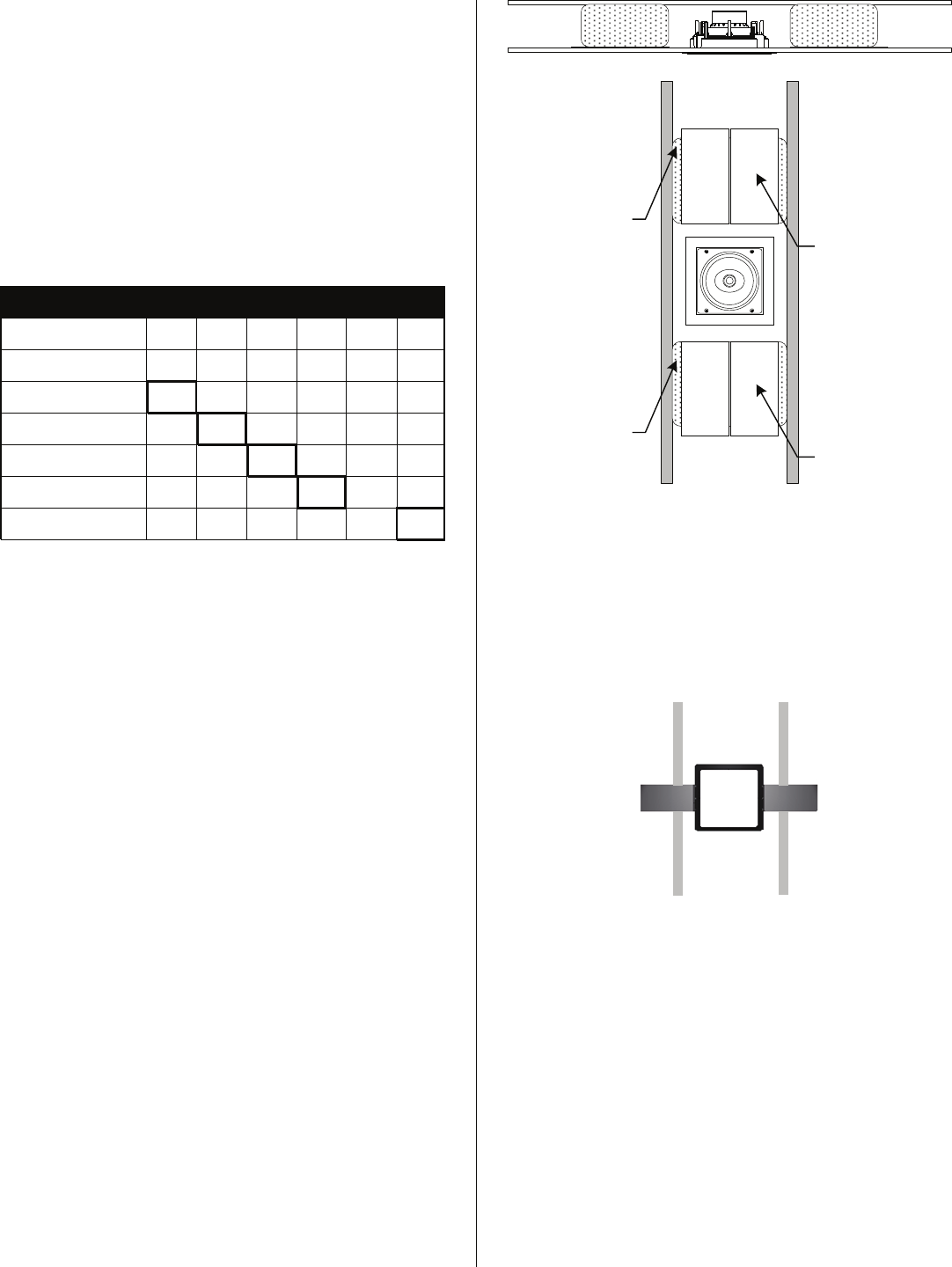
2
WIRE GAUGE AND QUALITY
PREPARING THE INSTALLATION LOCATION
Sonafill
®
Insulating the ceiling cavity
The total wire resistance should be less than 10% of the speaker
impedance. If using an 8 ohm speaker, your total wire resistance
should be no more than 0.8 ohms.
In simple terms, the extra resistance from the wire will have a very
negative effect on the sound quality of the speaker. The sound can be
less dynamic, definition of bass frequencies can be reduced, and in
extreme cases, the high frequencies can be attenuated. Amplifier
power is also wasted in the wire, reducing the maximum output level
of the system.
Please refer to the following chart when deciding on the appropriate
wire gauge for your installation.
Wire resistance in Ohms vs. length of cable run
Distance in Feet
50' 100' 150' 200' 250' 300'
.86
.65
.43
.27
.17
.11
18 gauge
16 gauge
14 gauge
12 gauge
10 gauge
20 gauge
1.73
1.30
.85
.54
.34
.22
2.59
1.94
1.28
.81
.51
.33
3.45
2.59
1.71
1.08
.68
.44
4.32
3.24
2.14
1.35
.85
.56
5.18
3.89
2.56
1.62
1.02
.67
Speaker performance can be enhanced by insulating the cavity with
fiberglass insulation.
When installing speakers in a ceiling, it is best to lay a sheet of
unfaced fiberglass insulation over the back of the speaker.
To further improve the sound quality, install insulation in the bays
adjacent to the speaker location. This will reduce noise produced by
the unsupported drywall.
Sonafill is a retrofitable acoustical treatment for loudspeakers that
virtually eliminates the noise produced by resonating drywall and
dramatically improves mid-bass sound quality. Sonafill also reduces
room-to-room noise especially in multi-channel installations where
many speakers are installed.
The Sonafill system consists of two pillows and four tiles. Installation is
accomplished by first adhering the tiles to the inside of the cavity, then
stuffing the two pillows in place behind the tiles.
The Sonafill System
All Sonance speakers are designed to be relatively insensitive to
changes in enclosure volume. To achieve the ultimate performance
from the C201SQ speaker, a section of the ceiling bay can be
sectioned off to form a back box. Building this enclosure will create a
dramatic improvement in the quality of bass response and power
handling.
Back box volume requirements:
C201SQ 1.15 cubic feet (32.55 liters)
Acoustic Pillow
Acoustic Pillow
Damping Tiles
Damping Tiles
Retrofit
New Construction
C201SQ FlexBracket
The C201SQ speaker feature an integral RotoLock
®
mounting system
for quick mounting into ceilings. The C201SQ FlexBracket is only
necessary in new construction installations when reserving a location
for the speaker is desired.
The FlexBracket will serve as a guide for the drywaller when cutting
holes for in-ceiling speakers. The FlexBracket is nailed or screwed to
the joists so that the hole is in the desired location once the drywall is
installed.
With the RotoLock system, the speaker can be installed directly into
existing ceilings. Once the hole is cut and the cable is run, the
speakers can be installed in a matter of seconds.
Once you have determined the area you would like to locate your
speakers, you will need to do an obstruction survey. Before you cut
the hole for the speaker, be certain no joist, conduit, pipe, heating
duct or air return will interfere with the speaker.
The C201SQ speaker requires a 7-5/16" x 7-5/16" cutout. There must
also be 3-3/4" of depth within the ceiling for the speaker.
A cut-out template is provided in the packaging of the speaker.
Position the template where the speaker is to be located and pencil an
outline on the ceiling. If you are unsure about obstructions, drill a
small hole in the center of the circle and insert a coat hanger into the
hole to feel for possible obstructions. If no obstructions are found,
proceed with cutting the hole using a drywall saw and run the speaker
wires.






